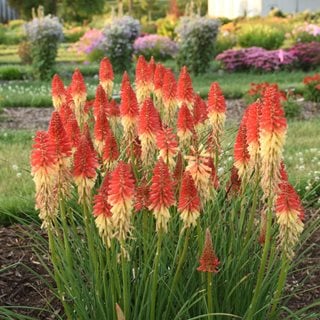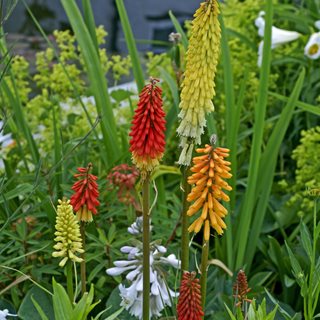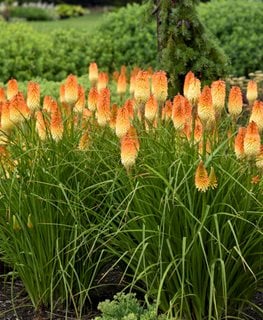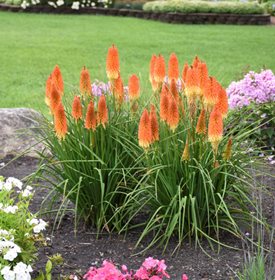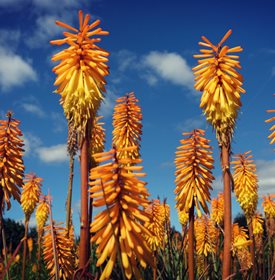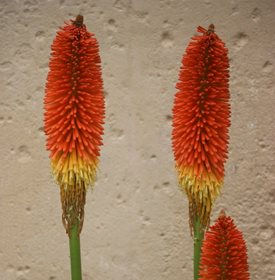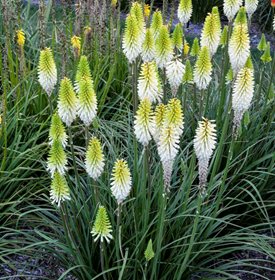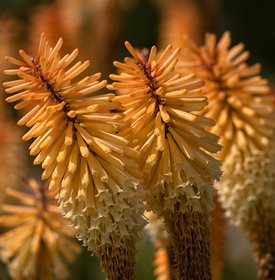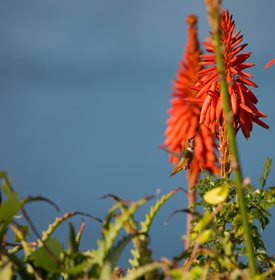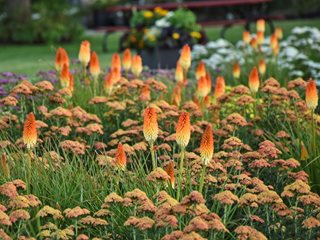HOW TO GROW RED HOT POKER PLANTS IN YOUR GARDEN
These show-stopping flowers add bright color and vertical interest to the landscape Published 3/11/2022For drama and tropical flair, few plants can rival the statuesque flower spikes of Kniphofia. This rhizomatous perennial is commonly known as tritoma, red hot poker plant, or torch lily, though it is not a true lily. The exotic-looking flowers, which resemble glowing pokers or tiki torches, occur during summer and fall in tones of red, orange, yellow, chartreuse, and white.
Native to South Africa, there are 70 species, though most garden varieties are hybrids. Kniphofia is tolerant of heat and drought, is low maintenance and resistant to most pests and diseases. Here’s how to grow red hot poker plants and use them in your landscape.
On this page: Basics | Planting | Care | Varieties | FAQ's | Design Tips
KNIPHOFIA BASICS
Botanical name:
Kniphofia uvaria other spp. and hybrids
Plant type:
Rhizomatous perennial; can be grown from seed, but is most commonly grown from potted transplants or tuberous roots.
Zones:
5-9
Exposure:
Full sun
Habit:
Upright clumping habit
Height/Spread:
2 to 6 feet tall, 1 to 3 feet wide, depending on variety
Bloom Time:
Early summer to fall, depending on variety
Flowers:
Vertical bottle brush blooms consist of dense clusters of smaller tubular flowers that open from the bottom to the top. Blooms occur on tall slender stems in hues of red, orange, peach, coral, apricot, yellow, chartreuse, or cream, some with bicolor or multicolors.
Foliage:
Narrow stiff green foliage has a grass-like appearance, forming a dense evergreen or semi-evergreen clump.
Are red hot pokers poisonous?
Kniphofia is generally regarded as non-toxic to pets and children, though ingesting any non-edible plant can cause digestive upset.
Are red hot pokers deer resistant?
Kniphofia is considered deer resistant, though damage can occur on almost any plant if other food sources are scarce.
Other attributes:
Kniphofia is tolerant of salt, making it a good choice for coastal gardens. The flowers are highly attractive to hummingbirds, butterflies, and other insect pollinators.
HOW TO PLANT RED HOT POKERS
When to plant:
Plant in spring when all danger of frost is past.
Where to plant:
Red hot pokers grow best in a wind-protected site with rich, well-drained soil that receives at least 6 to 8 hours of direct sun per day.
How to plant:
Loosen soil in planting area and lightly amend with compost or other organic matter. If plants are pot-bound, gently tease out the roots. Dig a hole slightly larger than the root ball and place in the planting hole so the top of the root ball is level with the surrounding soil. Fill in the hole with soil, tamp down gently to remove air pockets, and water thoroughly. Water plants regularly until established.
Soil:
Kniphofia is tolerant of a range of soils as long as there is good drainage. Plants perform best in moderately rich soil with a pH between 6.0 and 7.5. Amend the existing soil with compost or other rich organic matter before planting. Poorly draining soil can cause root or crown rot. For containers, use a high quality all-purpose potting mix.
RED HOT POKER CARE
Water:
Red hot poker plants perform best with moderate watering. Plants are drought tolerant once established. Avoid overwatering to prevent crown or root rot. Container plants will need more frequent watering, particularly during hot spells.
Amendments and fertilizer:
Plants need little to no supplemental fertilizer as long as soil is amended well. If desired, feed with an all-purpose slow-release fertilizer in spring to promote more plant vigor and flowering.
Pruning and deadheading:
Foliage is prone to winter damage, particularly in colder climates. Cut back old foliage in spring before new growth emerges. Remove spent flower spikes down to the base throughout the growing season to promote new blooms.
Dividing:
Plants benefit from dividing every few years to prevent overcrowding, which can result in fewer blooms. In early spring, dig up the entire clump. Use a spade or sharp knife to slice through the root ball, making several divisions. Replant divided rhizomes, making sure there is visible growth. Don’t plant the top of the rhizomes more than 3 inches below soil level. In warmer regions, plants can also be divided in fall after flowering.
Overwintering:
In USDA zones 5-6, plants will need winter protection. Add a layer of mulch such as straw or leaves over the crown of the plant in fall to protect from freezing temperatures. The foliage can be gathered and tied together above the crown to help prevent water from seeping into the crown.
Pests and diseases:
When given the right growing conditions, Kniphofia is virtually free from pests and diseases. Pests can include thrips, slugs or snails. Diseases, which are primarily due to wet conditions or poor drainage, include root or crown rot.
RED HOT POKER VARIETIES
FREQUENTLY ASKED QUESTIONS
Does kniphofia come back every year?
Kniphofia is a perennial in USDA zones 5-9, though plants in zones 5-6 will need winter protection.
Does kniphofia spread?
Plants develop robust clumps that can be divided every few years.
Are red hot pokers invasive?
Red hot poker may be invasive in parts of California and Oregon.
How do you keep red hot pokers blooming?
Provide rich soil and deadhead spent flower spikes to promote new blooms.
Where is the best place to plant red hot pokers?
Plant red hot poker in a sheltered sunny site with rich well-drained soil.
LANDSCAPING WITH KNIPHOFIA
For borders and landscapes: Use in beds and borders, curbside plantings and waterwise landscapes.
For slopes and hillsides: Mass along a slope or hillside to help stem erosion.
For containers: Feature a smaller variety as a stand-alone specimen in a container.
There are many ways to use red hot poker plants in your landscape. Here’s how:
- Use Kniphofia as a vertical element in a mixed border, repeating throughout the design to unify the landscape.
- Plant torch lilies alongside a water feature to add drama and contrast.
- Add to a cottage-style border alongside other favorites such as Shasta daisies, yarrow, Jupiter’s beard (Centranthus), salvia, and lilies.
- Plant in a butterfly garden alongside other butterfly-attracting plants such as lantana, beebalm, milkweed, Egyptian star flower (Pentas) and blazing star (Liatris).
- Use a smaller specimen in a container for a dramatic focal point in the landscape.
- Include Kniphofia in a cutting garden alongside other summer bloomers such as dahlias, zinnias, cosmos, coneflower, daisies and sunflowers.
- Plant varieties of red hot poker plants that bloom at different times to extend bloom time from early summer to mid fall.
- Create a tropical-themed border using red hot poker plants in combination with other bold, tropical-looking plants such as banana, canna lilies, elephant ears, lantana, coleus and hibiscus.
KNIPHOFIA COMPANION PLANTS:
Combine with other plants with summer interest such as beebalm (Monarda), black-eyed Susan (Rudbeckia), bluebeard (Caryopteris), catmint (Nepeta), coneflower (Echinacea), dahlias, daylily, lavender, ornamental grasses, Russian sage (Perovskia), salvia, Shasta daisies, sneezeweed (Helenium) and yarrow.
Related:
Native Plants
20 Drought-Tolerant Plants for Your Garden
Summer Flowers for Your Garden
